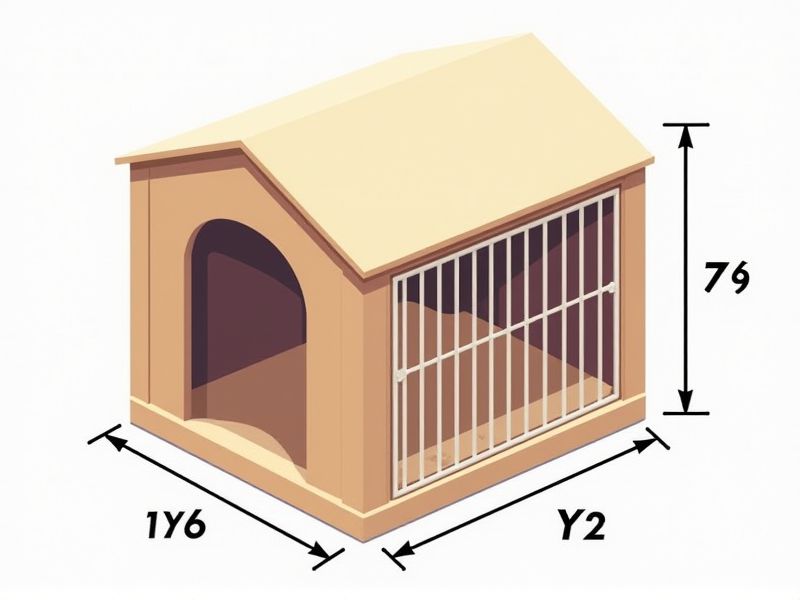
When selecting a pet kennel, understanding the standard dimensions helps ensure your pet has enough space for comfort and safety. For small dogs and cats, kennels typically measure around 24 inches long, 18 inches wide, and 19 inches high. Medium dogs often require kennels that are about 30 to 36 inches in length, 24 to 27 inches in width, and 25 to 28 inches in height. Always check your pet's size and compare it with the kennel's internal dimensions, ensuring they can stand up, turn around, and lie down easily for their well-being.
Size Requirements
Pet kennel standards vary significantly based on the size and breed of the animal. For example, the minimum dimensions for small breeds like Chihuahuas typically start at 24 inches long by 18 inches wide, while larger breeds such as German Shepherds require a minimum of 36 inches long by 30 inches wide. Height is also crucial--kennels should offer at least 30 inches of vertical space for large dogs to stand comfortably. When choosing a kennel, ensure it meets these specifications to provide your pet with a safe and comfortable environment.
Ventilation Features
Effective ventilation is crucial in a standard pet kennel to ensure optimal air quality and temperature control. A well-ventilated kennel typically includes adjustable vents and exhaust fans to facilitate airflow, maintaining an environment that remains between 68degF and 72degF. Proper ventilation not only helps prevent the buildup of harmful odors and moisture, but it also reduces the risk of respiratory issues in pets. When selecting a kennel for your pet, prioritize designs that offer a minimum of one square foot of ventilation for every 10 square feet of the kennel space.
Material Type
The standard of pet kennels emphasizes the importance of material type, with options including heavy-duty plastic, metal, and wood. Heavy-duty plastic kennels offer durability and are often weather-resistant, making them suitable for outdoor use. Metal kennels, particularly those made from galvanized steel, provide strength and security, reducing the risk of escape or damage. Wood kennels, while aesthetically pleasing, require proper treatment to withstand weather conditions and maintain longevity.
Assembly Ease
A pet kennel designed for optimal assembly ease typically features pre-drilled holes and color-coded components that simplify the construction process. Many models allow for tool-free setup, ensuring that you can quickly assemble or disassemble the kennel without hassle. Lightweight materials, such as durable plastic or aluminum, are often used to make handling and transport more convenient. By prioritizing these design elements, manufacturers aim to enhance user experience, making it easier for you to create a secure and comfortable space for your pet in no time.
Portability Options
When selecting a pet kennel, prioritizing portability is essential for ease of transport and convenience during travel. Look for kennels that weigh less than 10 pounds and feature collapsible designs for straightforward packing. Models with integrated handle systems often offer improved maneuverability, making it easier for you to navigate various environments. For optimal versatility, choose kennels made from lightweight materials such as plastic or aluminum, which enhance portability without compromising durability.
Cleaning Convenience
A high-quality pet kennel prioritizes cleaning convenience, featuring removable, washable liners to simplify maintenance. With materials such as stainless steel or non-porous plastics, these kennels resist staining and odors, ensuring a sanitary environment for your pet. The design often includes a seamless construction, minimizing crevices where dirt and bacteria can accumulate. Investing in a kennel that emphasizes easy cleaning can significantly enhance your experience and your pet's comfort.
Door Design
The door design of a pet kennel plays a crucial role in ensuring both safety and convenience for your pets. A well-constructed door should feature a secure locking mechanism, ideally using a latch system, to prevent escapes while allowing easy access for you. Opt for materials like stainless steel or heavy-duty plastic, which withstand wear and tear, with dimensions generally measuring 24 to 30 inches in width. Consider incorporating a double-door setup, providing an additional layer of security while facilitating smooth entry and exit, ensuring a stress-free environment for your pets.
Safety Features
A high-quality pet kennel prioritizes safety features to ensure the well-being of your furry friend. Look for materials such as heavy-duty steel or reinforced plastic, which can withstand wear and tear while preventing escape attempts. Additionally, ventilation should be optimized, with at least 1% of the kennel's surface area designed for airflow, allowing your pet to breathe comfortably. Safety latches, rounded edges, and non-toxic finishes further enhance the security of the kennel, creating a safe environment for your pet.
Comfort Padding
The comfort padding in pet kennels often features high-density foam, providing adequate support and cushioning for pets weighing up to 100 pounds. With removable and washable covers, these kennels ensure hygiene while maintaining a cozy environment for your furry companions. Many designs include waterproof liners to protect against accidents, enhancing durability and ease of cleaning. Look for kennels that utilize non-toxic materials to ensure safety for pets over prolonged periods.
Weight Limit
When selecting a pet kennel, understanding the weight limit is crucial for your pet's safety and comfort. Most kennels typically accommodate animals weighing anywhere from 10 to 150 pounds, depending on the model and brand. Always check the manufacturer's specifications to ensure your pet's weight aligns with the kennel's capacity, as exceeding the limit can result in structural failure or risk your pet's well-being. For proper ventilation and space, consider a kennel that offers additional room--ideally, at least 3 inches taller and longer than your pet when standing.
